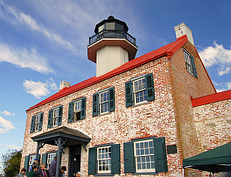|
|
-- Historic Sites - Lighthouses
-- Overview From the early years of its European settlement, the coastal shores, waters and weather of New Jersey became known for their hazards to shipping. Indeed, the first European woman believed to settle in the colony, Penelope Van Princis, a native of Amsterdam, was shipwrecked in 1640 off Sandy Hook and struggled ashore near the present-day Highlands, where her husband was murdered by Lenni Lenapes and she was brutally slashed and left for dead. After hiding for several days and tending to her wounds alone, she was discovered by other Native Americans, who cared for her, nursing her back to health and ultimately taking her by canoe to the Dutch town of Nieuw Amsterdam. Four years later, Penelope married Richard Stout, an Englishman, and after coming to New Jersey the couple would begin a family whose descendants, estimated at some 500, would become one of the most prominent families of Monmouth County into the current century. In 1764, more than a century after Penelope Van Princis was shipwrecked, the colony of New York built the first lighthouse at Sandy Hook, financing its construction from a lottery and recognizing the importance of safer passage for shipping using its thriving port at New York Harbor. * Penelope Van Princis Stout, History of American Women As the New Jersey colony grew, shipping became the preferred choice for travel, not only to and from abroad but also for conveying people and goods to nearby colonial ports and settlements, compensating for the rudimentary paths and roads within the colonies. Following the Revolution, the new federal government made one of its first priorities the construction of lighthouses to aid ships to navigate safely along the shore and to and from emerging ports. Originally lit by open fires and later candles, the lights evolved in the 18th century to use whale oil and then kerosene, with the keeper responsible for maintaining the flame, cleaning the lens and occasionally issuing alerts of foundering ships and even conducting rescues. In the early 1800s, the technology of lenses improved with the introduction of the Fresnel (pronounced fray-nell) lens, developed by the French engineer Jean-Augustin Fresnel, which allowed stronger illumination through smaller beehive-shaped lenses fitted into more compact spaces. Weights were used to drop down the tower shaft to drive gears that caused the lens to revolve; after the weights descended to the bottom of the tower, the keeper hand cranked them back to the top for a new descent. Visibility of the light improved as acetylene gas as a fuel came into use in the 1900s, with the Cape May Lighthouse in 1934 becoming the first in the nation to install a sodium vapor lamp. By World War I, there were some 40 light stations-- lighthouses, lightships and range lights--along the 130-mile New Jersey coastline. As more sites converted to electricity or gas with automated lamps that turned on at dusk and shut off at dawn, several lighthouses dispensed with keepers. During World War II, lights were turned off to prevent their use as a navigation aid by German U-boats, but most lighthouses continued to be staffed by their keepers or civil defense members, who would use telescopes and binoculars to scan nearby waters to guard against potential U-boat attacks or landings by spies, as well as watching for friendly shipping that appeared to be in distress. More recently, lighthouses were taken out of service as radar and global positioning satellites allowed ships to improve their own navigation and knowledge of their position. In 2000, the federal government encouraged state and local governments and nonprofit groups to assume control and conservation of deactivated lighthouses with the enactment of the National Historic Lighthouse Preservation Act of 2000. Today, eleven New Jersey lighthouses, several maintained by the state or nonprofit conservation groups, are open for public visits. The nonprofit New Jersey Lighthouse Society, with its focus on the New Jersey, Delaware Bay and New York Harbor regions, is one of the largest regional lighthouse societies in the United States, promoting appreciation of the history of lighthouses and supporting their preservation. The Coast Guard currently maintains a fleet of fourteen 175-foot Keeper Class Buoy Tenders to service the remaining lighthouses and lightships in operation. One of those ships, the Katherine Walker with its home port in Bayonne, is named for one of the few women to have served as a keeper, who after her husband's death in 1890 succeeded him as keeper of the Robbins Reef Light Station offshore of Bayonne, raising two children and maintaining the light (known to many as 'Kate's Light') for some thirty years. * New Jersey Lighthouse Society * State-owned Historic Sites * National Register of Historic Places-New Jersey
 East Point Lighthouse. Image: State of NJ East Point Lighthouse. Image: State of NJ
East Point Lighthouse (Maurice River Township)
Commenced operation 1849 at mouth of Maurice River on Delaware Bay in Cumberland County, known for many years as Maurice River Lighthouse. Light automated 1911, decommissioned by Coast Guard 1941. Severely damaged by fire 1971, restoration begun by Maurice River Historical Society with aid of federal and state funds new lantern and roof installed. Open to public on 3rd Sunday of month from April to October and for other special events. Current site threatened by encroaching waters of bay, shore now less than 120 feet from structure, down from 174 feet in 2008.
|












